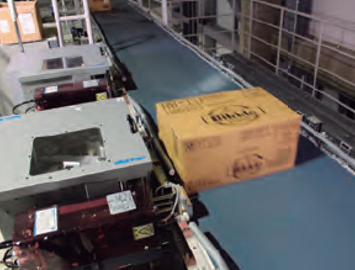Retail Distribution Centers

In recent years, the labor shortage within the logistics industry is a problem increasingly in the spotlight. According to a survey, the labor shortage is most pronounced in the area of transportation (71.9%), with loading and unloading (69.2%), and distribution processing (51.1%) following.
Due to this, personnel expenses for distribution center workers is on the rise. In areas with a large number of distribution facilities in particular, there is a scramble to hire experienced workers. Meaning that wage increases and better working environments are required to assemble a workforce.
With further decreases in the number of workers anticipated, the labor shortage for distribution sites will continue to worsen. To maintain distribution networks, control rising labor costs, and improve working conditions, the need for automation only grows.
Logistics for Medium and Large Retail Stores
Retail industry distribution centers frequently act as both distribution and transfer centers. Meaning that they provide storage (distribution), and sorting, collecting, and shipping (transfer) functionality. Most distribution centers aimed towards supermarkets and specialty stores have both functions and provide optimized product supply and delivery. They are either built by stores or are outsourced to third party logistics companies.
Operation Flow for Non-Perishable Foods and Everyday Goods
The arrival of goods is processed differently in the distribution center (DC) and the transfer center (TC) systems. Goods that enter the DC system are split based on shipping frequency in to four categories: very high (SA), high (A), medium or low (B/C), and small goods (subset of C). They are then stored based on volume, frequency and shipping form. In comparison, goods that enter the TC system are not stored, but rather are carried by conveyers straight to the sorting system.

Storage Flow
-

1. DC system goods are inspected upon arrival using handheld scanners.
-

2. SA group goods, which are shipped in large quantities, are stored by pallet.
-

3. Goods in group A are stored automatically using Sorting Transfer Vehicles (STVs). These reduce the amount spent on forklift drivers and increase warehouse safety.
-

4. STVs carry the A group goods to a dual-type unit load AS/RS for storage.
-

5. B and C group goods are stored in a mini load AS/RS.
-

6. Small goods are stored in the unit load AS/RS and are automatically supplied to the picking locations. Workers manually add them to the flow rack.
-

7. TC goods are unloaded from trucks directly onto conveyers and are automatically inspected by barcode readers installed above the conveyors.
Shipping Flow
-

1. SA cases are picked from the rear side of the pallet racking and put on conveyers.
-

2. Group A cases are moved from the unit load AS/RS to the picking station, and after being picked are put on conveyers. The dual type system increases the storage and retrieval throughput of the unit load AS/RS.
-

3. B and C goods are retrieved by case from the mini load AS/RS.
-

4. Small goods are collected from the flow rack using a picking cart.
-

5. After being picked, cases are labeled by an automatic labeler.
-

6. DC goods are combined with TC goods and are automatically sorted onto different chutes based on destination.
-

7. From the chutes, cases are sorted on to carts based on type or store aisle. For small stores, cases are sorted on to chutes based on shipping route, and then added to carts based on store.
Contact Us
For product inquiries, please reach out to us via our Contact Us page.
Contact UsContact Us
For product inquiries, please reach out to us via our Contact Us page.
Contact Us